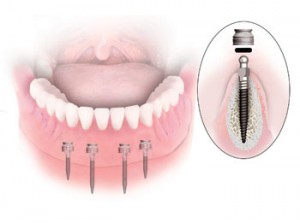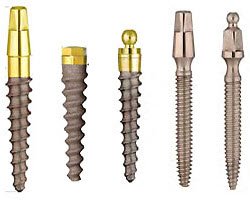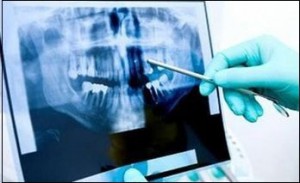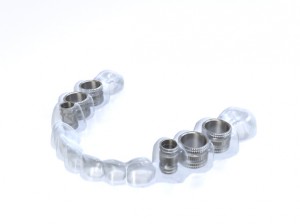Bloodless dental implantation

Bloodless dental implantation - implantation of implants, which is carried out without a gum incision.
The technique has been widely used in clinics in European countries, it is minimally invasive, since surgical intervention is minimized.
A feature of bloodless implantation is that the implant is installed using the puncture method.
For implantation, special screw implants are used.
Minor tissue damage allows the fixation of the temporary crown almost immediately, which solves the patient’s aesthetic problem.
Requirements
To install the implant by puncture, the following conditions must be met:
- The results of the examination should confirm the body's ability to quickly recover after surgery.
- The presence of the required amount of bone tissue, sufficient for stable fixation of the implant.
- Gum condition should be normal.
- The presence of teeth, next to the implant to be installed, because until the osseointegration of the structure with the bone, they will have to take on the entire functional load.
Benefits
Bloodless implantation has some advantages over other methods:

- Minimum invasiveness. Implants, implanted in the jawbone have a non-separable design, which significantly reduces implantation time, and there is no need to re-cut the gum to install the abutment. During the operation, microscopic incisions are made in the gum, through which the implant is implanted.
- The manufacture and fixation of the dental crown is carried out simultaneously with the installation of the implant and in the coming days.
- Sufficiently quick healing of soft tissues after surgery, the absence of swelling and bleeding.
- Implants can be installed simultaneously with tooth extraction, which cannot be treated. After tooth extraction, titanium structures are implanted. For their correct fixation, stitching of soft tissues is performed.
- The method is ideal for those patients who are panicky afraid of the type of blood and operations. This type of implantation is possible even in smokers.
- Minimum contraindications for the operation.
- Quick procedure.
- Restoration of the dentition.
- Correct formation of the gingival contour from the first day of implant placement.
- The patient acquires new teeth in just one day.
- The cost of surgery, compared with classical implantation, is much lower.
Thus, bloodless implantation allows you to install dentures almost immediately and there is no need to wait for the implant to engraft within three to six months.
Indications
- Recommended for patients whose work is closely related to people. Already on the day of surgery, the patient can go home with new teeth.
- Fast restoration of several front teeth.
- Narrow crest of the alveolar ridge.
- Comprehensive restoration of the teeth of the entire jaw in the presence of a slight deficiency of bone tissue.
Contraindications
There are diseases when implantation is not recommended:
- The presence of cardiovascular disease.
- Blood disease.
- Oncological diseases.
- Diseases of the immune system.
- Age is under 16 years.
- Connective tissue diseases.
- AIDS.
Diseases that have a negative effect on implant engraftment:
- Ischemic heart disease.
- The presence of renal failure.
- Diabetes.
- Irradiation of the neck and head.
- Addiction.
- Alcoholism.
- Smoking abuse.
- Pregnancy.
- The use of anticoagulants.
- Scleroderma.
- Rheumatic polyarthritis.
- Systemic lupus erythematosus.
- Blood diseases.
- Viral infections.
- Chronic somatic diseases.
Video: “Bloodless Dental Implantation”
Stages
The technique of bloodless implantation consists of several stages.
Diagnostics
The method of computed tomography is an X-ray examination.
As a result, the doctor assesses the quantity and quality of bone tissue, the location of the airways in the upper jaw and nerve channels in the lower jaw.
3D computer planning

3D planning is the most important part of the preparatory phase.
A detailed analysis of the obtained data is required, as well as the involvement of other specialists: surgeon, orthopedist, orthodontist, dental technician, therapist.
After the analysis is carried out, a computer simulation of the jaw is performed with the placement of the implant, taking into account the future denture.
As a result, the specialist determines the position, depth and angle of the implant with maximum accuracy.
This approach eliminates errors during the implant implantation operation.
Surgical Template Making

After the implants are selected and placed in the computer program, an individual surgical template is made at the plant based on CT data and 3D computer planning.
Guide bushings made of titanium are pressed into it, in the position of which information about the direction of the axis and the drilling depth of the holes in the jaw bone is laid.
Fixing the template on the jaw
The use of the template allows precise positioning of the implant, which eliminates the trauma of the roots of adjacent teeth, nerves, nasal cavity and maxillary sinuses. Using the template ensures predictability of the final result, and also gives confidence that the treatment is carried out in the right direction. This reduces the time of surgery and reduces the risk of injury.
Implant placement
The operation is performed without cutting the gums and subsequent suturing.
The implant is implanted through a small hole in the gum, while the gingival contour former is installed.
Laser application
If it is not possible to have bloodless implantation surgically, then laser tooth implantation can be performed.
Laser implantation is distinguished by the absence of blood loss at the time of the operation, as well as a quick regeneration period and the presence of minimal discomfort in the postoperative period.